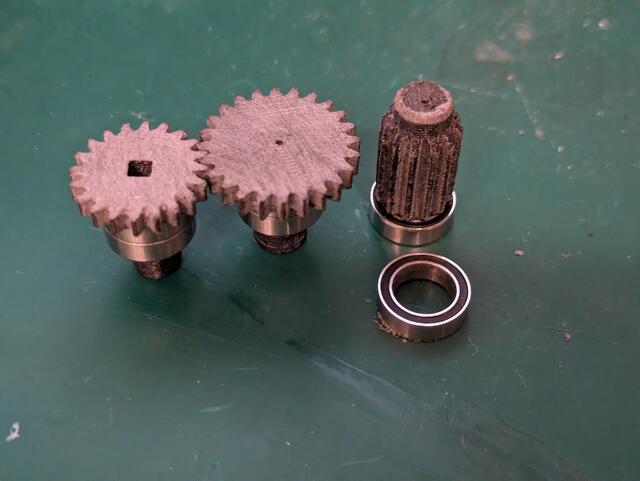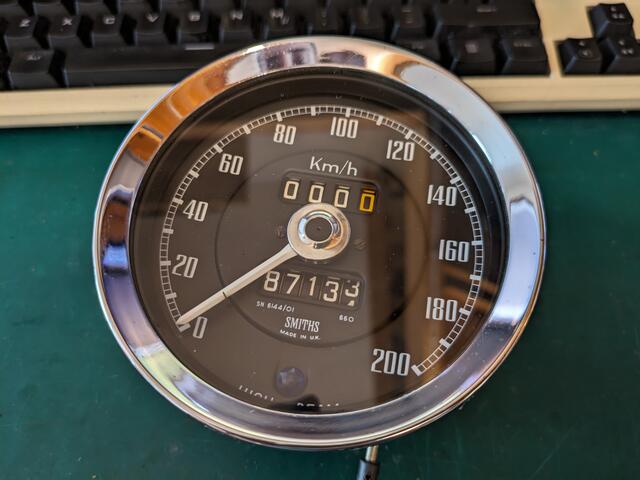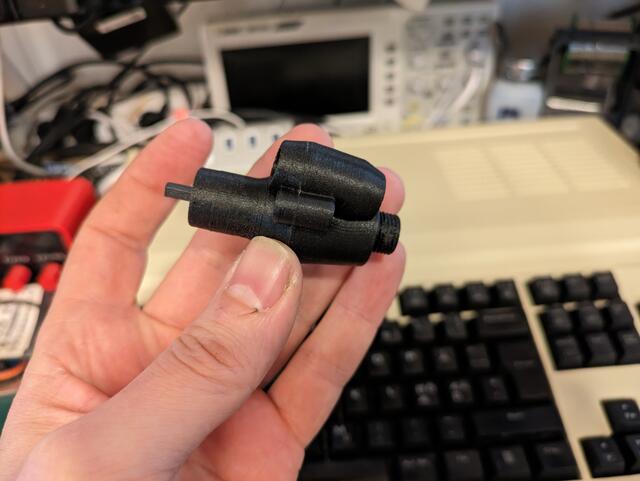MGB & GT Forum
I made a little 3D printed reduction drive to change the speedo gear ratio.
Posted by Lynxman
|
Topic Creator (OP)
Apr 14, 2024 09:03 AM
Top Contributor
Joined 7 weeks ago
82 Posts
|
|
My car is a 1966 GT according to the VIN and at one point it was upgraded to a 4 syncro gearbox with an overdrive (in the 80's I think). They obviously didn't compensate for this by changing the speedo (It says 660 on the speedo if that says anything) and I noticed the speed reading was always about 25% too high. To see where the problem was I drove a known distance of 96,6 km and compared to the odometer, which ended up with 116,7 km. About 20% too high. I needed to spin the speedo cable slower to both read the correct speed and count the correct distance. After taking the speedometer apart I saw there wasn't any realistic way of doing it inside without a lot of effort as I'd have to change the magnetism as well as the internal gearing.
I set about designing a little inline gearbox with a 1,2:1 ratio. I made 32 dp gears in 20 and 24 teeth with a 12 tooth idler. It all fit together well with both the speedo and cable nut on the first try so that was lucky. 12mm threads with 1 mm pitch, or whatever the imperial equivalent of that is, threaded on perfectly. I was a little worried that it wouldn't fit behind the dash but with the casing rotated so it pointed upwards it cleared the structure behind the dash just fine. Now all that remained was to do another test drive to see what kind of speeds and distance it read.
At 50 km/h the GPS speed was ~48 km/h and at 80 km/h indicated the GPS speed was ~75 km/h. Closer than some modern cars. The distance counted ended up as 46,3 km compared to 46,1 measured by the GPS. About 0,4% error. That's so close that I can't even improve on it without using much finer gear pitch. Pretty good result.
3D printing is great.
While on the longer drive I weighed my car at a weighing station. 1060 kg with half a tank of gas without me in the car seems a bit high.
Edited 1 time(s). Last edit at 2024-04-14 09:04 AM by Lynxman.
I set about designing a little inline gearbox with a 1,2:1 ratio. I made 32 dp gears in 20 and 24 teeth with a 12 tooth idler. It all fit together well with both the speedo and cable nut on the first try so that was lucky. 12mm threads with 1 mm pitch, or whatever the imperial equivalent of that is, threaded on perfectly. I was a little worried that it wouldn't fit behind the dash but with the casing rotated so it pointed upwards it cleared the structure behind the dash just fine. Now all that remained was to do another test drive to see what kind of speeds and distance it read.
At 50 km/h the GPS speed was ~48 km/h and at 80 km/h indicated the GPS speed was ~75 km/h. Closer than some modern cars. The distance counted ended up as 46,3 km compared to 46,1 measured by the GPS. About 0,4% error. That's so close that I can't even improve on it without using much finer gear pitch. Pretty good result.
3D printing is great.
While on the longer drive I weighed my car at a weighing station. 1060 kg with half a tank of gas without me in the car seems a bit high.
Edited 1 time(s). Last edit at 2024-04-14 09:04 AM by Lynxman.
Attachments:
|
wildfireman
Lewis Evans
|
Apr 14, 2024 10:16 AM
Joined 2 years ago
329 Posts
|
Wow, you might patent that. Perhaps you could make odometer gears for the early 1020 and 1040 speedometers and go into business. Almost all of them crack resulting in jumping needles. The early speedos have two gears, I expect you know all of this as you are working on a 1966. Very good work.
|
Topic Creator (OP)
Apr 14, 2024 10:36 AM
Top Contributor
Joined 7 weeks ago
82 Posts
|
|
|
ATHENS, GA, USA
Sign in to contact
1963 Triumph Spitfire "The Angry Hornet"
1966 MG MGB GT 1968 Triumph Spitfire MkIII 1970 Triumph GT6+ (MkII) |
Apr 14, 2024 11:32 AM
Top Contributor
Joined 6 years ago
20 Posts
|
|
wildfireman
Lewis Evans
|
Apr 14, 2024 11:56 AM
Joined 2 years ago
329 Posts
|
Yes, one odometer gear drives the odometer, the other drives the speedometer needle. They snap on the end of the shafts and typically crack between the teeth resulting in a momentary decrease in speed, i.e. hang up, and the needle jumps or the numbers on the dial do not roll smoothly. Your speedo is in kph, the mph versions show 1020 for od , 1040 for non od and this is turns per mile. Yours show 660 so maybe this is turns per kilometer. A company in Virginia USA makes replacement gears, their name is Odometer gears, a bit pricey.
|
Apr 14, 2024 11:58 AM
Top Contributor
Joined 18 years ago
17,667 Posts
|
|
Very good work.
The adaptors are available but at $100-200 https://mrspeedometer.com/products/ratio-adapter?variant=47209621576
The adaptors are available but at $100-200 https://mrspeedometer.com/products/ratio-adapter?variant=47209621576
|
Topic Creator (OP)
Apr 14, 2024 12:13 PM
Top Contributor
Joined 7 weeks ago
82 Posts
|
|
When I looked Inside I thought one gear drove the odometer and the other drove the trip meter. The needle seemed to be driven directly through via the magnet. Didn't look to hard once I saw it was too much work to redo.
Edited 1 time(s). Last edit at 2024-04-14 12:18 PM by Lynxman.
Edited 1 time(s). Last edit at 2024-04-14 12:18 PM by Lynxman.
|
Topic Creator (OP)
Apr 14, 2024 12:14 PM
Top Contributor
Joined 7 weeks ago
82 Posts
|
|
In reply to # 4785000 by ClayJ
Very good work.
The adaptors are available but at $100-200 https://mrspeedometer.com/products/ratio-adapter?variant=47209621576
The adaptors are available but at $100-200 https://mrspeedometer.com/products/ratio-adapter?variant=47209621576
Nice site. Lots of ratios to choose from with their box. Not the one I would need though. 1,204 would be perfect but it's close enough now with 1,2. I'm refining my little gearbox and will upload 3D printable parts to Cults3D once I'm satisfied.
Edited 1 time(s). Last edit at 2024-04-14 12:16 PM by Lynxman.
|
wildfireman
Lewis Evans
|
Apr 14, 2024 12:54 PM
Joined 2 years ago
329 Posts
|
|
filospinato
Jake V
Manassas, VA, USA
Sign in to contact
1954 Austin-Healey 100 "Field Healey"
1954 Austin-Healey 100 "Jack Rabbit" ~ For Sale ! ~ 1965 MG MGB MkI "Persimmon" ~ For Sale ! ~ 1977 MG MGB MkIV "Martin" |
Apr 14, 2024 07:34 PM
Top Contributor
Joined 19 years ago
2,522 Posts
|
|
Topic Creator (OP)
Apr 15, 2024 03:30 AM
Top Contributor
Joined 7 weeks ago
82 Posts
|
|
filospinato thanked Lynxman for this post
|
Apr 15, 2024 04:28 AM
Top Contributor
Joined 3 years ago
804 Posts
|
|
|
Bumpa
Mike Howlett
|
Apr 15, 2024 05:13 AM
Top Contributor
Joined 1 year ago
498 Posts
|
|
Topic Creator (OP)
Apr 15, 2024 05:31 AM
Top Contributor
Joined 7 weeks ago
82 Posts
|
|
I used GreenTEC Pro CF which can handle the exteme heat of a summer car interior: https://www.extrudr.com/shop-eu/products/greentec-pro-cf/
This material is also easy to print with as it has extremely little warping, even less than PLA. You can probably use the non CF version just fine, or ABS/ASA/PETG if you can print that without warping. I need the CF infused version to achieve the strength needed for high RPM electric ducted fans in RC planes. My other hobby is RC planes and I design and fly large 3D printed jets with multiple kW of power: [url=]Jet video[/url]
I also designed and printed a powerful electric centrifugal supercharger using this material. It creates 5 psi boost with the engine revving in a beater I'm using as a test car.
PLA is stronger but can't handle the heat of a hot car interior. I did try to print one of the gearboxes from PLA and ran it at much higher RPM on the bench here and it survived just fine.
I redesigned it to be more compact and put both the input and output gear perfectly inline so that I could use a ball bearing between them to prevent rubbing without glueing. The idler is angled to achieve this. Spins relatively smoothly with little resistance. 3D printed gears aren't perfect but they work well enough that I can drive hours in my RC racing cars as long as there's a thin layer of grease, even PLA.
Edited 1 time(s). Last edit at 2024-04-15 05:33 AM by Lynxman.
This material is also easy to print with as it has extremely little warping, even less than PLA. You can probably use the non CF version just fine, or ABS/ASA/PETG if you can print that without warping. I need the CF infused version to achieve the strength needed for high RPM electric ducted fans in RC planes. My other hobby is RC planes and I design and fly large 3D printed jets with multiple kW of power: [url=]Jet video[/url]
I also designed and printed a powerful electric centrifugal supercharger using this material. It creates 5 psi boost with the engine revving in a beater I'm using as a test car.
PLA is stronger but can't handle the heat of a hot car interior. I did try to print one of the gearboxes from PLA and ran it at much higher RPM on the bench here and it survived just fine.
I redesigned it to be more compact and put both the input and output gear perfectly inline so that I could use a ball bearing between them to prevent rubbing without glueing. The idler is angled to achieve this. Spins relatively smoothly with little resistance. 3D printed gears aren't perfect but they work well enough that I can drive hours in my RC racing cars as long as there's a thin layer of grease, even PLA.
Edited 1 time(s). Last edit at 2024-04-15 05:33 AM by Lynxman.
Attachments:
filospinato thanked Lynxman for this post
|
Topic Creator (OP)
Apr 15, 2024 05:58 AM
Top Contributor
Joined 7 weeks ago
82 Posts
|
|
Forums 

Having trouble posting or changing forum settings?
Read the Forum Help (FAQ) or contact the webmaster















